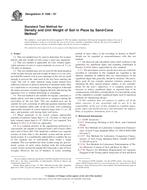Potřebujeme váš souhlas k využití jednotlivých dat, aby se vám mimo jiné mohly ukazovat informace týkající se vašich zájmů. Souhlas udělíte kliknutím na tlačítko „OK“.
ASTM D558-11
Standard Test Methods for Moisture-Density (Unit Weight) Relations of Soil-Cement Mixtures
Automaticky přeložený název:
Standardní zkušební metody pro vlhkost, hustota (Unit Hmotnost) vztahy k půdě cementové směsi
NORMA vydána dne 1.1.2011
Informace o normě:
Označení normy: ASTM D558-11
Poznámka: NEPLATNÁ
Datum vydání normy: 1.1.2011
Kód zboží: NS-31750
Počet stran: 6
Přibližná hmotnost: 18 g (0.04 liber)
Země: Americká technická norma
Kategorie: Technické normy ASTM
Kategorie - podobné normy:
Zemní práce. Hloubicí práce. Budování základů. Podzemní práce
Anotace textu normy ASTM D558-11 :
Keywords:
compaction, dry density, optimum water content, soil-cement, soil-stabilization, unit weight, Compaction measurement--soils, Maximum dry density, Moisture-density (MD) relationships, Soil-cement, Soil-moisture analysis, ICS Number Code 93.020 (Earth works. Excavations. Foundation construction. Underground works)
Doplňující informace
| Significance and Use | ||||||||||||||||||||||||||
|
These tests determine the optimum water content and maximum density (unit weight) to be used for molding soil-cement specimens in accordance with Test Methods D559 and D560. Note 1—Since these tests are used in conjunction with Test Methods D559 and D560 and the criteria referenced therein, the test differs in several aspects from Test Method D698. There are three main differences between this standard and Test Method D698. Firstly, this standard allows a maximum particle size of ¾-in. (19.0 mm) for a 4-in. (101.6-mm) mold while Test Method D698 allows a maximum particle size of 3/8-in. (9.5-mm) for the same size mold. Secondly, this standard permits the material leftover after the water content specimen has been obtained to be mixed with the rest of the sample and reused for the next determination. Test Method D698 does not permit the material to be reused. Thirdly, this standard allows the material that is retained on the ¾-in. (19.0-mm) and passing the 3-in. (75-mm) to be discarded (scalping technique) and replaced with an equal mass of material that passes the ¾ -in. (19.0-mm) sieve and is retained on the No.4 (4.75-mm) sieve. Test Method D698 does not permit the scalp and replacement technique. Note 2—The quality of the result produced by this standard is dependent on the competence of the personnel performing it, and the suitability of the equipment and facilities used. Agencies that meet the criteria of Practice D3740 are generally considered capable of competent and objective testing/sampling/inspection/etc. Users of this standard are cautioned that compliance with Practice D3740 does not in itself assure reliable results. Reliable results depend on many factors; Practice D3740 provides a means of evaluating some of those factors. |
||||||||||||||||||||||||||
| 1. Scope | ||||||||||||||||||||||||||
|
1.1 These test methods cover the determination of the relationship between the water content and the density of soil-cement mixtures when compacted before cement hydration as prescribed. 1.2 A 1/30-ft 3 (944-cm3) mold and a 5.50-lbf (24.5-N or mass of 2.49-kg) rammer dropped from a height of 12.0 in. (30.5 cm) are used and two methods, depending on soil gradation, are covered, as follows: |
||||||||||||||||||||||||||
| 2. Referenced Documents | ||||||||||||||||||||||||||
|
Podobné normy:
Historická
15.6.2013
Historická
1.7.2007
Historická
15.2.2009
Historická
15.9.2007
Historická
1.5.2012
Historická
1.10.2010



 ASTM D1143/D1143M-07..
ASTM D1143/D1143M-07.. ASTM D1241-07
ASTM D1241-07 ASTM D1452-09
ASTM D1452-09 ASTM D1556-07
ASTM D1556-07 ASTM D1557-12
ASTM D1557-12 ASTM D1558-10
ASTM D1558-10
 Cookies
Cookies
